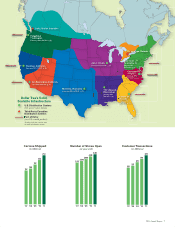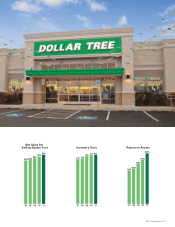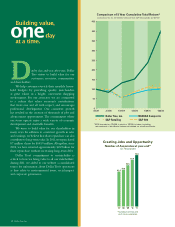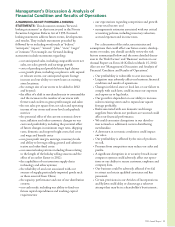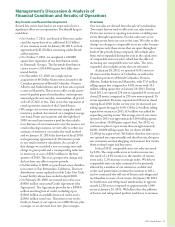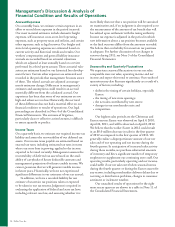Dollar Tree 2011 Annual Report Download - page 18
Download and view the complete annual report
Please find page 18 of the 2011 Dollar Tree annual report below. You can navigate through the pages in the report by either clicking on the pages listed below, or by using the keyword search tool below to find specific information within the annual report.
and improve our merchandise allocation to our stores.
We believe that this has enabled us to better manage our
inventory flow resulting in more efficient distribution and
store operations and increased inventory turnover for
each of the last five years.
In 2007, legislation was enacted that increased the
Federal Minimum Wage. e last increase to $7.25 an
hour was effective in July 2009. As a result, our wages
increased in the third quarter of 2009 through the first
half of 2010 compared with the comparable period in the
prior year; however, we offset the increase in payroll costs
through increased productivity and continued efficiencies
in product flow to our stores.
We must continue to control our merchandise costs,
inventory levels and our general and administrative
expenses as increases in these line items could negatively
impact our operating results.
0DQDJHPHQW·V'LVFXVVLRQ$QDO\VLVRI
)LQDQFLDO&RQGLWLRQDQG5HVXOWVRI2SHUDWLRQV
sales and earnings by increasing the number of shopping
trips made by our customers. In addition, we accept food
stamps (under the Supplemental Nutrition Assistance
Program (“SNAP”)) in approximately 3,860 qualified
stores compared to 3,500 at the end of 2010.
With the pressures of the current economic
environment, we have seen continued demand for basic,
consumable products in 2011. As a result, we have
continued to shift the mix of inventory carried in our
stores to more consumer product merchandise which we
believe increases the traffic in our stores and has helped
to increase our sales even during the current economic
downturn. While this shift in mix has impacted our
merchandise costs we were able to offset that impact in
the current year with decreased costs for merchandise in
many of our categories.
Our point-of-sale technology provides us with valu-
able sales and inventory information to assist our buyers
Results of Operations
e following table expresses items from our consolidated statements of operations, as a percentage of net sales. On
January 31, 2010, the first day of fiscal 2010, we began using approximately 30 inventory pools in our retail inventory
calculation, rather than one inventory pool as we had done since our inception. As a result of this change, we recorded
a non-recurring, non-cash charge to gross profit and a corresponding reduction in inventory, at cost, of $26.3 million in
the first quarter of 2010.
Year Ended
January 28, 2012 January 29, 2011 January 30, 2010
Net sales 100.0% 100.0% 100.0%
Cost of sales, excluding non-cash beginning
inventory adjustment 64.1% 64.1% 64.5%
Non-cash beginning inventory adjustment 0.0% 0.4% 0.0%
Gross profit 35.9% 35.5% 35.5%
Selling, general and administrative expenses 24.1% 24.8% 25.7%
Operating income 11.8% 10.7% 9.8%
Interest expense, net — (0.1%) (0.1%)
Other income, net — 0.1% —
Income before income taxes 11.8% 10.7% 9.7%
Provision for income taxes (4.4%) (3.9%) (3.6%)
Net income 7.4% 6.8% 6.1%
16 Dollar Tree, Inc.



